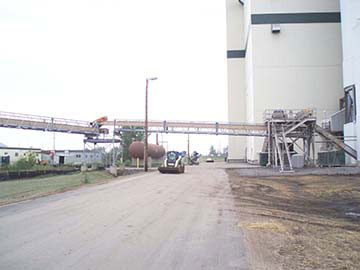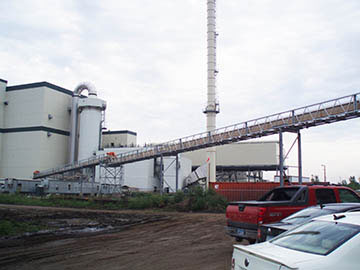Biomass Power Generation
Utility Uses Farm Waste to Generate Power and Capitalizes on Revenue Streams
Download PDF
CHALLENGE
CDM was contracted to provide a layout, conveyors, drives, structural steel towers and catwalk trusses for approx. 500 ft. of the conveying distance. Total conveying distance of the product is approximately 600 ft. Conveyors were designed at a rate of 20 TPH of Ash. In the event of boiler failure the conveyors are also required to handle the unburned fuel at a rate that exceeds 20 TPH.
PRODUCTS UTILIZED
Drop-Forged Chain
En-Masse Conveyor
Generating Power from Waste
A new electric power generating facility was designed to use non-fossil fuel as the energy source in the boiler. Located in Benson, Minnesota the fuel for the steam generation process would be poultry litter obtained from area farms. The litter consists of excrement, feed, feathers, and pieces of wood particles from the bedding. Not only was the litter a good source of energy for the power producer, but the ash collected from the burn process is nutrient rich and can be sold as fertilizer. The fuel is used to generate 55 megawatts (MWs), making it the largest poultry litter fired power plant in the United States. The energy produced is purchased by a larger provider for use on their supply grid.
The power generating facility contracted a third party to handle the ash from the burn process. The third party was responsible for taking the ash from the bottom ash conveyors off the boilers and transporting the material to a warehouse 200 yards from the plant on a neighboring property. The third party would process and sell the fertilizer as fertilizer.
CDM was contracted by the 3rd party to provide a layout, conveyors, drives, structural steel towers and catwalk trusses for approx. 500 ft. of the conveying distance. Total conveying distance of the product is approximately 600 ft. Conveyors were designed at a rate of 20 TPH of Ash. In the event of boiler failure the conveyors are also required to handle the unburned fuel at a rate that exceeds 20 TPH.
Principle Matters
 The CDM approach to conveyor design starts from the inside out. The full application and site details are collected and then the design work begins with selecting the optimum chain for the application. Once the chain is selected, the frame and components are designed around the chain. The third party who contracted CDM to design and build the conveyors, structural supports and service towers recognized they needed a system that would provide long-life with minimal maintenance and virtually no unplanned downtime. If the conveyors were down, the third party distributor could not collect the ash and produce the fertilizer for resale.
The CDM approach to conveyor design starts from the inside out. The full application and site details are collected and then the design work begins with selecting the optimum chain for the application. Once the chain is selected, the frame and components are designed around the chain. The third party who contracted CDM to design and build the conveyors, structural supports and service towers recognized they needed a system that would provide long-life with minimal maintenance and virtually no unplanned downtime. If the conveyors were down, the third party distributor could not collect the ash and produce the fertilizer for resale.
-
Objective: Conveying Distance
a. Ash is an abrasive product. The best way to ensure long-term conveyor operation and durability is to design for minimal chain speed and maximum conveyor lengths.
-
Design Parameters
b. Using the En-Masse principle of material handling CDM was able design the conveyors to operate at minimal chain speed using a skeletal chain with lower chain weight and horsepower (HP) consumption. Only four conveyors were required to move the volume of ash. Two of the conveyors are required due to change in direction. The number and size of conveyors were minimal when compared to the requirements of other conveying technologies. The high volume capacity and efficient utilization of space inherent in the En-Masse design kept the number and size of the conveyors low and saved the power producer thousands of dollars in construction equipment and ownership costs.
- c. Inside the conveyor is a CDM drop-forged chain. The CDM chain is unlike many other drag chains available. The CrMn alloy drop-forged chain has a core hardness and ductility set at 300-400 BHN. The formula and machine tolerances of the chain and bolt assemblies allows for the longest lasting chain in the industry and are engineered to operate 24/7 in the harshest of operating conditions. For this application, the CDM 142& 175 series was selected. Often round link, combination, or engineered class chain are selected for ash handling applications; however these types of chain are not typically as well suited to withstand the abrasive nature of ash and are often misapplied. The hardness formula of the CDM chain combined with the chain strength allowed for chain speeds that would provide extended chain and component life and minimal maintenance over time.
-
- i. The use of En-Masse conveying technology eliminated the need for physically larger conveyors with greater HP requirements and dual strand chain assemblies. These design elements have the potential for increased routine maintenance to mitigate catastrophic failure.
-
Structural
d. CDM provided all structural steel from plant termination location to the third party storage building. The height and distance were key elements of the structural design because the trusses needed to accommodate truck traffic and avoid utilities at a distance that spanned multiple drain ditches.
e. The trusses also provided continuous access to conveyors, service platforms, and towers to allow low access for maintenance.
-
Design Parameters
f. CDM worked with a local surveying company to locate and finalize the layout and provide foundation locations. The final structural design accommodated both the site and conveyor configurations.
A Model Business Case
The success for both the power producer and the third party distributor was the consistent, reliable movement of the ash from the boilers to the ash processing facility on the neighboring property.

The design, selection, and engineering of the ash handling conveying system and structural supports took into account the characteristics of the material conveyed, the volume, the conveying distance, and accessibility requirements. These elements were used to calculate the required chain strength under acceptable chain pull.
The goal of design was to provide the most durable conveyors that required the least amount of HP to operate and required minimal maintenance. Keeping this goal in mind, CDM provided a series of EnMasse conveyors that allowed both parties to successfully deliver a product for resale.
Browse By Benefit
Categories
- Blog (40)
- Case Studies (9)
- News (7)
- Product Information (7)
- Tech Briefs (3)
- Technical Documents (33)
- Uncategorized (1)
- Videos (12)
- White Papers (5)

